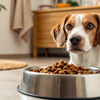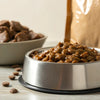Is It Bad to Feed Your Dog Wet Food Every Day? A Comprehensive Guide
- Houndsy
Table of Contents
- Introduction
- Understanding Wet Dog Food
- Pros of Feeding Your Dog Wet Food
- Cons of Feeding Your Dog Wet Food
- Mixing Wet and Dry Food
- What to Look for in Wet Dog Food
- Health Considerations
- Reflecting on Your Pet's Needs
- Conclusion
Introduction
As responsible dog parents, we constantly strive to provide the best for our furry companions. One pivotal choice we face is what kind of food to serve them. The growing focus on pet nutrition has led many of us to consider the implications of feeding dogs wet food daily. But is it bad to feed your dog wet food every day? The answer isn't black and white; it involves understanding the specific needs of our dogs and the characteristics of their diet.
Recent data shows that over 60% of dog owners have switched to including wet food in their pets' diets. This shift is often due to the palatability of wet food, especially for picky eaters and older dogs who may have difficulty chewing. Here at Houndsy, we believe that the way we feed our pets significantly affects their health and happiness. In this post, we will explore whether it's bad to feed your dog wet food every day and delve into the advantages and disadvantages this diet can present.
We invite you to reflect on your own pet feeding practices as we dissect the various components of wet dog food, alternative feeding options, and how our innovative solutions, like the Houndsy Kibble Dispenser, can enhance your dog feeding experience.
Understanding Wet Dog Food
What Is Wet Dog Food?
Wet dog food, commonly available in cans or pouches, has a high moisture content—often upwards of 70-80%. This high moisture percentage offers various benefits, including hydration and palatability, particularly for finicky eaters.
How Is Wet Dog Food Made?
Wet dog food typically consists of high-quality meat, vegetables, grains, and other nutritional supplements. It is processed through a multi-step procedure:
- Ingredient Preparation: Ingredients like meats and vegetables are first prepared.
- Cooking and Sealing: The mixture is sealed in cans and cooked at high temperatures to ensure safety and longevity.
- Quality Control: Brands vary significantly in nutrition quality. It is paramount to choose products that are free from fillers and low-quality ingredients.
Nutritional Composition
While the nutritional value of wet dog food can vary greatly from brand to brand, high-quality wet food often delivers balanced nutrition that satisfies the dietary needs of dogs, including protein, fats, vitamins, and minerals.
Pros of Feeding Your Dog Wet Food
1. Hydration Benefits
The most evident advantage of wet dog food is its high moisture content. Proper hydration is critical for a dog's health, promoting kidney function and helping maintain fluid balance, particularly in dogs that may have urinary or kidney issues.
2. Palatability
Wet food is generally more aromatic and flavorful than dry food, enticing dogs who may otherwise avoid their meals. This is especially beneficial for older dogs and those recovering from illness.
3. Easier to Chew and Digest
Wet food is softer than dry kibble, making it easier for senior dogs or those with dental issues to consume. Its moisture content also aids in digestion, ensuring that the food is easier on the stomach.
4. Appealing to Picky Eaters
A dog that turns its nose up at dry kibble often finds wet food enticing due to its flavorful nature and variety of textures. This can be an effective way to ensure they consume enough calories.
5. Nutritional Variety
Incorporating wet food allows for varied proteins and nutrients, reducing the monotony often associated with kibble-only diets. This diversity in taste can stimulate appetite and provide necessary nutrients.
Cons of Feeding Your Dog Wet Food
1. Potential Dental Issues
One concern with exclusively feeding wet food is the lack of crunchy texture, which can contribute to plaque buildup on a dog's teeth. This is less of a concern if pet owners supplement with dental chews and regular dental check-ups.
2. Cost Considerations
Wet food is typically more expensive than dry food, which can make it less feasible for daily feeding, particularly for larger breeds. Balancing the budget is important for many pet owners.
3. Storage and Spoilage
Unlike dry kibble that can be left out for extended periods, opened cans of wet food must be refrigerated and used within a specified time frame. This necessity can create more waste if not managed properly.
4. Possible Weight Gain
While many high-quality wet foods are lower in carbohydrates, some brands may be calorie-dense and contain fillers that could contribute to unwanted weight gain in less active dogs. Monitoring portion sizes is crucial here.
5. Less Convenient
The time and effort required to serve wet food can be considered a drawback, especially for busy pet parents. Canned food needs preparation and cleanup that kibble does not.
Mixing Wet and Dry Food
One popular approach to mitigate the downsides of both types of food is the mixing strategy. By combining wet and dry dog food, we can provide our pets with a variety of textures and flavors while maintaining the benefits each type offers.
Why Mix Wet and Dry?
- Enhanced Flavor: Mixing can significantly improve the taste experience for dogs, helping to maintain their interest in meals.
- Nutritional Balance: Combining the two ensures the pet receives a full spectrum of nutrients, benefitting from the high-fat content of wet food and the dental benefits of dry food.
- Cost-Effective: Mixing allows owners to use less wet food, making the overall diet more financially manageable without sacrificing flavor or hydration.
Tips for Mixing Wet and Dry Food
- Gradually introduce wet food alongside dry kibble to avoid digestive upset.
- Use a 70/30 ratio of dry to wet food for balanced nutrition and texture.
- Monitor your dog's weight to ensure you are not overfeeding.
What to Look for in Wet Dog Food
Choosing the right wet dog food requires vigilance and knowledge. Here’s what to keep an eye on:
- High-Quality Ingredients: Look for meats listed as the first ingredient and avoid fillers like corn and wheat.
- Guaranteed Analysis: Check the nutritional information to ensure it has adequate protein, moisture, fiber, and fat content.
- Manufacturer Reputation: Trustworthy brands have proven track records and transparency about ingredient sourcing and processing methods.
Health Considerations
When Is Wet Food Recommended?
In certain circumstances, wet food can be particularly advantageous:
- Senior Dogs: Lifelong comfort while transitioning to softer diets is important for aging pets.
- Picky Eaters: Dogs that refuse to eat should be encouraged with wet food.
- Illness Recovery: Dogs recovering from surgery or illness often need something easier to digest.
- Hydration Needs: Dogs prone to urinary tract issues benefit from added moisture.
Veterinary Insights
Consulting with a veterinarian is always recommended. They can provide personalized feeding guides based on dietary requirements specific to your dog’s age, size, activity level, and overall health.
Reflecting on Your Pet's Needs
As we explore our options, it’s essential to think about our individual dogs' needs and preferences. Engaging with your pet before incorporating significant diet changes can enhance the experience.
- How does your dog respond to wet food?
- Have you noticed any changes in their energy or coat condition?
- Are they more enthusiastic during mealtime?
Conclusion
Is it bad to feed your dog wet food every day? The answer leans toward no, considering the quality and balance of nutrition provided. Wet food can offer essential hydration, palatability, and ease of consumption, especially for certain dogs needing a little more tender care. However, it’s vital to consider dental health, cost implications, and ensure nutritional adequacy.
Incorporating a blend of wet and dry food, along with high-quality options like the Houndsy Kibble Dispenser for dry food, can elevate our dog's feeding experience. At Houndsy, we aim to simplify and enhance your daily feeding routine with thoughtful design and functionality, allowing you to focus on what truly matters: the bond between you and your furry friend.
FAQ Section
1. Can I feed my dog wet food every day?
Yes, high-quality wet food can be fed daily, provided it's nutritionally balanced and suits your dog's individual needs.
2. Do I need to transition my dog from dry to wet food?
It's best to gradually introduce wet food to avoid digestive discomfort, especially if the dog is accustomed to kibble.
3. Will feeding wet food cause obesity in dogs?
Not necessarily. Obesity relies more on calorie intake versus expenditure. It's important to monitor portions, regardless of whether you feed wet or dry food.
4. Is wet food better for puppies and senior dogs?
Yes, puppies and seniors often benefit from the easy-to-chew texture of wet food and its enriched moisture content.
5. How can I combine wet and dry food effectively?
Begin mixing small amounts of wet food into your dog's dry food, increasing the ratio gradually while keeping an eye on caloric intake and adjustments to their body condition.
6. Should I worry about my dog's dental health with wet food?
While wet food may contribute to plaque buildup, you can mitigate this with regular dental care practices and treats designed to promote oral health.
For those of us invested in elevating our pet care routines, invite you to explore how the Houndsy Kibble Dispenser can seamlessly enhance your feeding experience. Check it out here.












